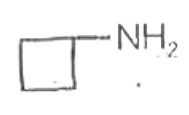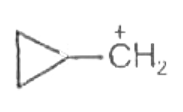Assertion: - 3∘ carbocations are more stable than 1∘ and 2∘ carbocations.
Reason :- The+I effect of alkyl groups decreases the magnitude of positive charge to the maximum possible extent in a 3∘ carbocation
If both Assertion and Reason are CORRECT and Reason is the CORRECT explanation of the Assertion.
If both Assertion and Reason are CORRECT but Reason is not the CORRECT explanation of the Assertion.
If Assertion is CORRECT but Reason is INCORRECT.
If Assertion is INCORRECT but Reason is CORRECT.
The correct Answer is:A
To solve the question regarding the stability of carbocations and the assertion and reason provided, we can break it down into the following steps:
Step 1: Understanding Carbocations
Carbocations are positively charged carbon species. The stability of carbocations is influenced by the number of alkyl groups attached to the positively charged carbon.
Step 2: Classifying Carbocations
Carbocations are classified based on the number of alkyl groups:
- Primary (1°) Carbocation: One alkyl group attached to the positively charged carbon.
- Secondary (2°) Carbocation: Two alkyl groups attached.
- Tertiary (3°) Carbocation: Three alkyl groups attached.
Step 3: Analyzing Stability
The stability order of carbocations is:
3°>2°>1°
This means that tertiary carbocations are more stable than secondary, which are more stable than primary carbocations.
Step 4: Inductive Effect
The stability of carbocations can be explained by the +I (positive inductive) effect of alkyl groups. Alkyl groups are electron-donating and help to disperse the positive charge on the carbocation:
- In a 3° carbocation, three alkyl groups donate electron density, stabilizing the positive charge effectively.
- In a 2° carbocation, two alkyl groups provide some stabilization.
- In a 1° carbocation, only one alkyl group is present, providing minimal stabilization.
Step 5: Evaluating the Assertion and Reason
- Assertion: "3° carbocations are more stable than 1° and 2° carbocations." This is correct based on the stability order discussed.
- Reason: "The +I effect of alkyl groups decreases the magnitude of positive charge to the maximum possible extent in a 3° carbocation." This is also correct and explains why the 3° carbocation is the most stable.
Conclusion
Both the assertion and reason are correct, and the reason provided is a valid explanation for the assertion.
Final Answer
- Assertion: True
- Reason: True
- Explanation: The +I effect of alkyl groups stabilizes the positive charge in carbocations, making tertiary carbocations the most stable.
---
Carbocations are positively charged carbon species. The stability of carbocations is influenced by the number of alkyl groups attached to the positively charged carbon.
Carbocations are classified based on the number of alkyl groups:
- Primary (1°) Carbocation: One alkyl group attached to the positively charged carbon.
- Secondary (2°) Carbocation: Two alkyl groups attached.
- Tertiary (3°) Carbocation: Three alkyl groups attached.
The stability order of carbocations is:
3°>2°>1°
This means that tertiary carbocations are more stable than secondary, which are more stable than primary carbocations.
The stability of carbocations can be explained by the +I (positive inductive) effect of alkyl groups. Alkyl groups are electron-donating and help to disperse the positive charge on the carbocation:
- In a 3° carbocation, three alkyl groups donate electron density, stabilizing the positive charge effectively.
- In a 2° carbocation, two alkyl groups provide some stabilization.
- In a 1° carbocation, only one alkyl group is present, providing minimal stabilization.
- Assertion: "3° carbocations are more stable than 1° and 2° carbocations." This is correct based on the stability order discussed.
- Reason: "The +I effect of alkyl groups decreases the magnitude of positive charge to the maximum possible extent in a 3° carbocation." This is also correct and explains why the 3° carbocation is the most stable.
Both the assertion and reason are correct, and the reason provided is a valid explanation for the assertion.
- Assertion: True
- Reason: True
- Explanation: The +I effect of alkyl groups stabilizes the positive charge in carbocations, making tertiary carbocations the most stable.
Topper's Solved these Questions
- BOOK - ICSECHAPTER - ORGANIC CHEMISTRY : SOME BASIC PRINCIPLES AND TECHNIQUES EXERCISE - NCERT TEXT-BOOK EXERCISES (WITH HINTS AND SOLUTIONS )72videos
ORGANIC CHEMISTRY : SOME BASIC PRINCIPLES AND TECHNIQUES
- BOOK - ICSECHAPTER - ORGANIC CHEMISTRY : SOME BASIC PRINCIPLES AND TECHNIQUES EXERCISE - FILL IN THE BLANK TYPE QUESTIONS46videos
ORGANIC CHEMISTRY : SOME BASIC PRINCIPLES AND TECHNIQUES
- BOOK - ICSECHAPTER - HYDROGENEXERCISE - NCERT TEXT-BOOK EXERCISE (With Hints and Solutions)53videos
HYDROGEN
- BOOK - ICSECHAPTER - REDOX REACTIONS (OXIDATION AND REDUCTION)EXERCISE - NCERT TEXT-BOOK. EXERCISES ((With Hints and Solutions)69videos
REDOX REACTIONS (OXIDATION AND REDUCTION)
Similar Questions
Benzyl carbocation is more stable than ethyl carbocation. Justify.
View SolutionA tertiary butyl carbocation is more stable than isopropyl carbocation. Justify.
View SolutionA tertiary butyl carbocation is more stable than a secondary butyl carbocation because of which of the following ?
View SolutionIn which of the following carbocations, delocalisation of positive charge is possible :
View SolutionAssertion : Carbocation are planar in nature.
Reason : Carbocations are sp2 hybridised.View SolutionAssertion : Hydroquinone is more acidic than resorcinol.
Reason : OH shows −I effectView SolutionWhat is the effect of introducing an alkyl group on the stability of carbocation?
View Solutionp-methyl benzyl carbocation (I) is more stable than benzyl carbocation (II).
Heterovalent or no bond resonance.View SolutionAssertion : N, N-Diethyl ethanamine is more basic the N, N-Dimethyl methanamine.
Reason : +I effect of ethyl group is more then methylView SolutionA:
 on raction with HNO2 gives
on raction with HNO2 gives  as major product.
as major product.
R: carbocation is more stable than
carbocation is more stable than  carbocation.View Solution
carbocation.View Solution

